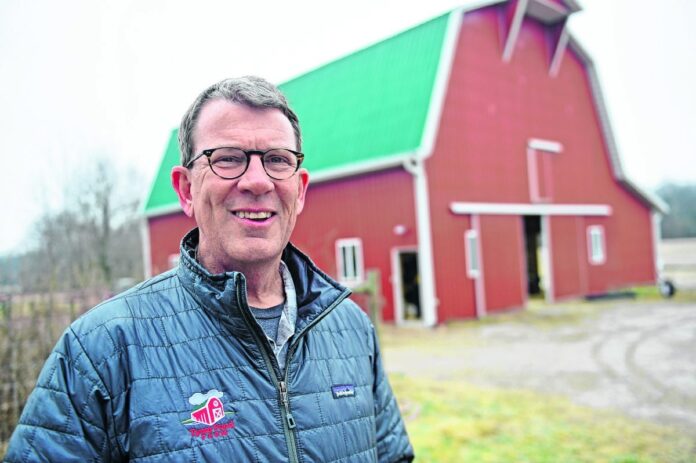
HANCOCK COUNTY — It starts with the soil.
The better the soil, the better the grass. The better the grass, the better the cattle. The better the cattle, the better the beef. And the better the beef, the better the business for Chris Baggott’s Tyner Pond Farm.
For this Hancock County entrepreneur and livestock farmer, the answer to getting great soil isn’t a new technology or chemical compound of the future, but imitating behavior that’s occurred in nature since hoofed animals first stepped onto grasslands. He recently traveled to another continent to see the livestock management practice in action and learn more about how to implement it at home.
[sc:text-divider text-divider-title=”Story continues below gallery” ]
Click here to purchase photos from this galleryOn several hundred acres in Indiana, the method is a way for Baggott’s farm to carry out its philosophy of holistic management and environmental responsibility. Across the world, the ecologist championing the practice calls it a way to turn deserts into grasslands and fight climate change.
Tyner Pond Farm is a U.S. Department of Agriculture organic-certified operation with about 500 acres spread across five farms in eastern Hancock County raising pigs, chickens and beef cows. Baggott also owns Greenfield-based restaurants The Mug and Griggsby’s Station, as well as Indianapolis-based ClusterTruck, a delivery-only restaurant.
He spent about a week in the Patagonia region of southern South America in early January learning about the livestock practice he’s now using with Tyner Pond Farm’s nearly 200 cows. The farm he visited was a hub of the Savory Institute, started by Zimbabwean ecologist and livestock farmer Allan Savory. Baggott was one of several farmers from throughout the U.S. on the trip.
“What you’re trying to do is mimic what happened in the natural world a million years ago,” he said of the management method.
Back when countless bison roamed North America’s plains, bunched in herds to keep safe from the predators surrounding them, they grazed and created intense pressure on the ground for a period of time before heading to another area.
It’s a much different scene today — when predators pose little threat and much of the grazing animals are livestock cattle spread out widely across pastures.
But when grazing animals are close together in smaller spaces, like the bison of yore, they’re eating much of the grass making up their surroundings, Baggott continued. Then they’re trampling the plants they don’t eat, along with their enriching carbon, into the soil. The animals are also fertilizing the area with their waste, further creating an ideal environment for more and healthier grass to grow later.
“The ground improves every year and gets better with this kind of management,” Baggott said. “So the idea is that there will be more grass next year than there was last year, depending on the way you manage it.”
Tyner Pond Farm applies the practice by connecting polywire to the electrified fencing surrounding its pastures to create smaller grazing areas and cycling cows through them.
“It’s not just ‘throw the cows out there, let them wander around and then go eat them,’” he said. “There’s a lot of math and calculation and planning and active management.”
It involves sizing paddocks based on the mass of a herd, measuring forage, keeping careful records and adapting when unexpected circumstances arise, Baggott continued.
He said the desire to implement the practice stemmed from Tyner Pond Farm’s focus on holistic management.
“How do you think about the entire operation holistically as it relates to the animal, as it relates to the ground, as it relates to the economics, as it relates to the people; and seeing one big picture of how do you create a good, happy life and a good, happy community, an economically viable business all at the same time?” he said.
Savory’s support for the practice is because of one big picture as well. In his 2013 TED Talk conference, he discussed his epiphany that grasslands thrive due to large numbers of grazing animals herding from pack-hunting predators.
Slide after slide in Savory’s presentation shows deserts across the world transformed into lush grasslands using livestock mimicking nature over the course of decades.
It takes carbon out of the atmosphere and safely stores it in grassland soils, Savory said. Done on a mass scale, it will bring carbon levels to pre-industrial levels while feeding people, he continued.
“There is only one option left to climatologists and scientists, and that is to do the unthinkable and to use livestock bunched and moving as a proxy for former herds and predators and mimic nature,” Savory said. “There is no alternative left to mankind.”





